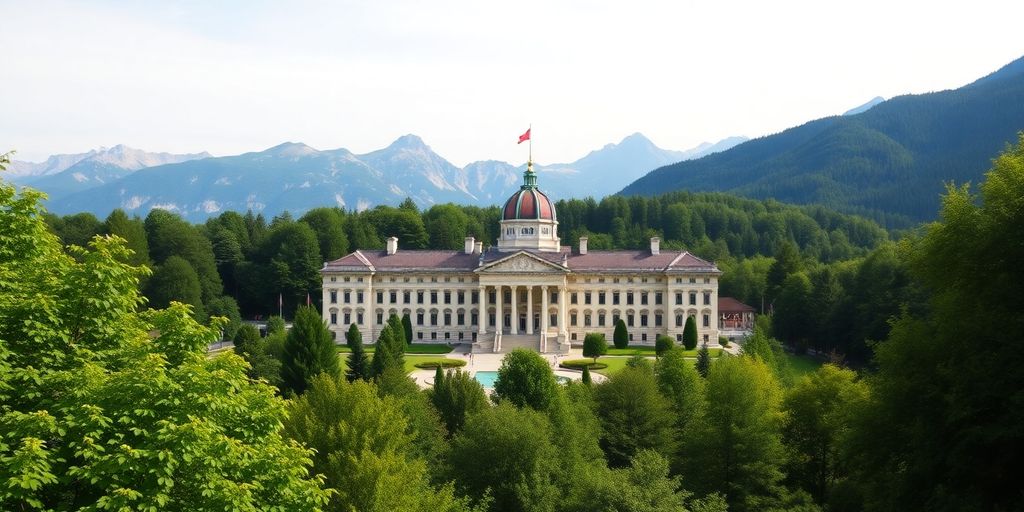Exploring The History of Switzerland: A Journey Through Time

Switzerland is a captivating country with a rich history that stretches back thousands of years. From its ancient beginnings to its modern achievements, the story of Switzerland is filled with fascinating events and remarkable people. This article will take you on a journey through time, exploring the key moments that shaped the Switzerland we know today.
Key Takeaways
- Switzerland’s history dates back to prehistoric times, with evidence of early settlements and farming communities.
- The formation of the Swiss Confederacy in 1291 marked the beginning of a united Switzerland, leading to independence and neutrality.
- The Protestant Reformation had a significant impact on Switzerland, with cities like Zurich becoming centers of religious change.
- Switzerland maintained its neutrality during both World Wars, acting as a mediator and refuge for those in need.
- Today, Switzerland is known for its political stability, cultural diversity, and global influence, making it a unique model in the world.
The Ancient Roots of Switzerland
Prehistoric Settlements and Discoveries
Switzerland’s history stretches back thousands of years. The earliest evidence of human life in the region dates back to the Paleolithic era, around 15,000 years ago. During the Neolithic period, which began around 5000 BCE, farming communities started to form. Archaeological findings show that these early settlers built homes and cultivated crops, laying the groundwork for future societies.
The Influence of the Celts
By the 6th century BCE, the Helvetii, a Celtic tribe, became the dominant group in Switzerland. They established settlements and developed a rich culture. The Helvetii were known for their skills in metalwork and trade, connecting them with other Celtic tribes across Europe. Their influence can still be seen in various place names and cultural practices in Switzerland today.
Roman Conquest and Integration
In the 1st century BCE, the Romans conquered the region, integrating it into the Roman Empire. This period brought significant changes, including the construction of roads, cities, and trade networks. The Roman province of Raetia, which included parts of modern Switzerland, became a vital area for commerce and military strategy. The Roman influence helped shape the culture and infrastructure of Switzerland, leaving a lasting legacy that can still be observed in the country’s architecture and urban planning.
Switzerland’s ancient roots reveal a complex tapestry of cultures and influences that have shaped its identity over millennia.
| Period | Key Developments |
|---|---|
| Paleolithic | Earliest human settlements (15,000 BCE) |
| Neolithic | Farming communities (5000 BCE) |
| Celtic Era | Helvetii tribe dominance (6th century BCE) |
| Roman Era | Integration into the Roman Empire (1st century BCE) |
Medieval Switzerland and the Rise of the Confederacy
Formation of the Old Swiss Confederacy
In 1291, three cantons—Uri, Schwyz, and Unterwalden—came together to form an alliance. This alliance marked the beginning of what would grow into the Swiss Confederacy. Over time, more cantons joined, creating a strong network of support and defense against outside threats.
Key Battles and Alliances
The Confederacy faced many challenges, but it also achieved significant victories. Some key events include:
- Battle of Morgarten (1315): A decisive victory against the Habsburgs.
- Battle of Sempach (1386): Another crucial win that solidified Swiss independence.
- Battle of Marignano (1515): A major battle that showcased the military prowess of the Confederacy.
These battles helped to strengthen alliances among the cantons and establish Switzerland as a formidable force in Europe.
The Role of Religion in Medieval Society
Religion played a vital role in shaping medieval Switzerland. The Catholic Church was influential, but the rise of Protestantism during the Reformation began to change the landscape. Key points include:
- The spread of Protestant ideas, especially in cities like Zurich and Geneva.
- Conflicts between Catholic and Protestant cantons, leading to civil strife.
- The eventual resolution of these conflicts, which helped to unify the country.
The early history of Switzerland begins with the earliest settlements up to the beginning of Habsburg rule, which in 1291 gave rise to the independence of the Swiss Confederacy.
Through these events, Switzerland laid the groundwork for its future as a neutral and independent nation, setting the stage for its modern identity.
The Reformation and Its Impact

The Spread of Protestantism
The Reformation was a major movement that changed the course of Christianity. It began in the early 16th century and became the basis for the founding of Protestantism, one of the three major branches of Christianity. Key figures like Martin Luther and John Calvin played significant roles in spreading these new ideas across Europe, including Switzerland.
Religious Conflicts and Resolutions
As Protestantism spread, it led to various conflicts. In Switzerland, cities like Zurich and Geneva became centers of the Reformation. The disagreements between Catholics and Protestants often resulted in violence. However, over time, many of these conflicts were resolved through discussions and treaties, leading to a more peaceful coexistence.
Influential Figures of the Swiss Reformation
Several important leaders emerged during the Swiss Reformation:
- Huldrych Zwingli: A key figure in Zurich who promoted reform in the church.
- John Calvin: He established Geneva as a center for Protestant thought and practice.
- Heinrich Bullinger: Zwingli’s successor who helped spread Reformation ideas further.
The Reformation not only changed religious practices but also influenced politics and society in Switzerland, leading to a more democratic and diverse culture.
Switzerland During the Napoleonic Era
The Helvetic Republic Experiment
During the late 18th century, Switzerland faced significant changes due to the Napoleonic Wars. In 1798, the French invaded and established the Helvetic Republic, aiming to unify the country under a central government. This new government was meant to replace the old system of cantonal independence. However, it faced many challenges, including:
- Resistance from local leaders
- Economic difficulties
- Conflicts between different regions
Napoleon’s Influence on Swiss Politics
Napoleon’s control over Switzerland was marked by his efforts to reshape its political landscape. He introduced reforms that aimed to modernize the country, such as:
- Centralized administration
- Legal reforms based on the Napoleonic Code
- Changes in education and infrastructure
Despite these changes, many Swiss people felt a loss of their traditional freedoms. The Congress of Vienna in 1815 eventually restored the old cantonal system, but the influence of Napoleon remained evident in Swiss governance.
Restoration of the Confederacy
After the fall of Napoleon, Switzerland returned to a confederate structure. The new federal system allowed for:
- Greater autonomy for cantons
- A balance of power among different regions
- A focus on neutrality in international affairs
This period laid the groundwork for modern Switzerland, emphasizing stability and cooperation among its diverse regions.
The Napoleonic era was a time of great change for Switzerland, shaping its future as a neutral and unified nation.
Industrialization and Modernization in the 19th Century
Economic Transformation and Growth
In the 19th century, Switzerland experienced rapid economic growth. This period marked the beginning of industrialization, which transformed the country from a primarily agricultural society to an industrial powerhouse. Key factors included:
- The development of the textile industry, especially in cities like Zurich and Basel.
- The expansion of the railway network, which connected various regions and facilitated trade.
- The rise of banking and finance, making Switzerland a hub for investments.
Social Changes and Urbanization
As industries grew, many people moved from rural areas to cities in search of jobs. This led to significant social changes:
- Increased population density in urban areas.
- The emergence of a working class with new social dynamics.
- Improved living standards for many, although challenges like overcrowding and poor working conditions also arose.
The Development of Swiss Infrastructure
Infrastructure development was crucial during this time. The government invested in:
- Roads and railways to improve transportation.
- Communication systems, including telegraph lines.
- Public services like education and healthcare, which laid the groundwork for modern Switzerland.
The 19th century was a turning point for Switzerland, as it came to terms with being a center of innovation and economic activity in Europe. This transformation set the stage for its future as a stable and prosperous nation.
Overall, the industrialization and modernization of Switzerland in the 19th century were pivotal in shaping its identity and economic landscape, leading to a period of stability and growth that continues to this day.
Switzerland in the World Wars
Neutrality and Its Challenges
Switzerland is known for its neutrality during both World Wars. This position allowed the country to avoid direct involvement in the conflicts. However, maintaining neutrality was not easy. The Swiss had to navigate complex political situations and ensure their borders were secure.
Economic and Humanitarian Efforts
During World War I, Switzerland faced an economic crisis. The country accepted nearly 300,000 refugees, including many military internees. This influx of people put pressure on Swiss resources but also showcased the nation’s commitment to humanitarian efforts.
The Aftermath and Reconstruction
After both wars, Switzerland emerged relatively unscathed compared to its neighbors. The country focused on rebuilding and strengthening its economy. The post-war period saw significant growth in various sectors, including finance and industry, which helped solidify Switzerland’s position as a stable and prosperous nation.
Switzerland’s ability to remain neutral during turbulent times has shaped its identity as a peaceful nation committed to humanitarian values.
Summary of Key Points
- Switzerland maintained neutrality during both World Wars.
- The country accepted a large number of refugees, showcasing its humanitarian efforts.
- Post-war reconstruction led to economic growth and stability.
Contemporary Switzerland: A Model of Stability

Switzerland is often seen as a model of stability in today’s world. Its unique political system and strong economy contribute to this reputation. The country is known for its:
- Political Neutrality: Switzerland has maintained a long-standing policy of neutrality, avoiding involvement in international conflicts.
- High Quality of Life: Citizens enjoy excellent public services, including healthcare and education, which contribute to a high standard of living.
- Economic Strength: The nation boasts a robust economy with low corporate tax rates and efficient capital markets.
Political Structure and Governance
Switzerland’s political system is a direct democracy, allowing citizens to participate actively in decision-making. This system includes:
- Federalism: Power is shared between the national and cantonal governments.
- Referendums: Citizens can vote on important issues, ensuring their voices are heard.
- Consensus Politics: Political parties often work together to achieve common goals, promoting stability.
Cultural Diversity and Integration
Switzerland is home to multiple cultures and languages, including:
- German, French, Italian, and Romansh: These languages reflect the country’s diverse heritage.
- Cultural Festivals: Events celebrating various traditions foster unity among different communities.
- Education and Integration Programs: These initiatives help newcomers adapt and contribute to society.
Switzerland’s Role in Global Affairs
Switzerland plays a significant role on the international stage, characterized by:
- Hosting International Organizations: Geneva is home to the United Nations and the Red Cross, making it a hub for diplomacy.
- Humanitarian Efforts: The country is known for its commitment to providing aid and support during crises.
- Economic Partnerships: Switzerland engages in trade agreements that benefit its economy and strengthen global ties.
Switzerland’s economic and political stability, transparent legal system, exceptional infrastructure, and efficient capital markets make it a unique example of a successful nation in the modern world.
Conclusion
In summary, Switzerland is a country filled with a rich and interesting past, stretching from ancient times to today. Its central location in Europe has made it a key place for trade, finance, and diplomacy for many years. Switzerland’s choice to stay neutral and its focus on human rights and protecting the environment have set a great example for other nations. Whether you are curious about history, culture, or the beautiful landscapes, Switzerland truly has something special for everyone.
Frequently Asked Questions
What is the history of Switzerland?
Switzerland has a long history that goes back over 8,000 years, starting from prehistoric times. It has seen various cultures, including the Celts and Romans, and has evolved into a neutral and stable country.
Why is Switzerland known for neutrality?
Switzerland is famous for its neutrality because it has not participated in any wars since 1815. This has allowed it to act as a mediator in international conflicts and host many international organizations.
What are some famous Swiss products?
Switzerland is well-known for its high-quality chocolate, cheese, and watches. Swiss chocolate is loved all over the world, and the country’s cheese, like fondue and raclette, is a big part of its culture.
How did Switzerland become a democracy?
Switzerland became a democracy in the 19th century, developing a stable government that values citizen participation. The country has a unique system of direct democracy, allowing people to vote on important issues.
What role did Switzerland play in the World Wars?
During both World Wars, Switzerland remained neutral. It provided humanitarian aid and served as a refuge for people fleeing conflict, maintaining its focus on peace and stability.
What makes Switzerland a popular tourist destination?
Switzerland attracts tourists with its beautiful landscapes, including the Alps, charming cities, and rich history. Visitors enjoy skiing, hiking, and exploring cultural sites, making it a diverse travel destination.








Responses